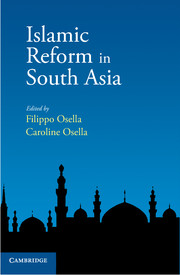Book contents
- Frontmatter
- Contents
- List of Contributors
- Introduction
- Part I Reformist Journeys
- Part II Debating Reform
- Part III Everyday Politics of Reform
- 11 Reading the Qur'an in Bangladesh: The Politics of ‘Belief’ Among Islamist Women
- 12 Cracks in the ‘Mightiest Fortress’: Jamaat-e-Islami's Changing Discourse on Women
- 13 Islamic Feminism in India: Indian Muslim Women Activists and the Reform of Muslim Personal Law
- 14 Disputing Contraception: Muslim Reform, Secular Change and Fertility
- Part IV Reform, State and Market
- Index
11 - Reading the Qur'an in Bangladesh: The Politics of ‘Belief’ Among Islamist Women
from Part III - Everyday Politics of Reform
Published online by Cambridge University Press: 05 January 2014
- Frontmatter
- Contents
- List of Contributors
- Introduction
- Part I Reformist Journeys
- Part II Debating Reform
- Part III Everyday Politics of Reform
- 11 Reading the Qur'an in Bangladesh: The Politics of ‘Belief’ Among Islamist Women
- 12 Cracks in the ‘Mightiest Fortress’: Jamaat-e-Islami's Changing Discourse on Women
- 13 Islamic Feminism in India: Indian Muslim Women Activists and the Reform of Muslim Personal Law
- 14 Disputing Contraception: Muslim Reform, Secular Change and Fertility
- Part IV Reform, State and Market
- Index
Summary
Introduction
In Muslim communities in contemporary South Asia and other Muslim-majority areas, informal religious lesson circles are proliferating rapidly as mass higher education brings more Muslims under the umbrella of standardized, nationalized education systems. These study circles often revolve around the study of compendia of Qur'anic commentary or exegesis, hadith (written records of sayings and acts attributed to the Prophet Muhammad) such as the thirteenth-century Riyad al-Salihin, as well as Qur'anic commentaries and theological texts produced by authoritative traditional religious scholars, contemporary or recent.
While some scholars have discussed contemporary commentaries on the Qur'an and their authors, fewer have focused on the users of these commentaries and of other Islamic literature, or on the specifics of audience engagement with these texts (Eickelman 2004). Thus, for instance, while the works of Sayyid Qutb (which are central to the Muslim Brotherhood, the leading Islamic movement in the Middle East and North Africa) have been analysed by several scholars (see, for example, Carré 2003; Kepel 1993 [1985]; Khatab 2006; and Moussalli 1992), some important questions are left unanswered: How are Qutb's ideas explained to adherents on the ground? What styles of discourse are employed in lesson circles? Which ideas are emphasized and which marginalized, and what kinds of techniques are used to do so? Do lesson circles actually shape how individual members feel, think, express themselves, and act? If so, how, and to what extent? Which groups are reading which texts or selections from texts?
- Type
- Chapter
- Information
- Islamic Reform in South Asia , pp. 283 - 316Publisher: Cambridge University PressPrint publication year: 2013

